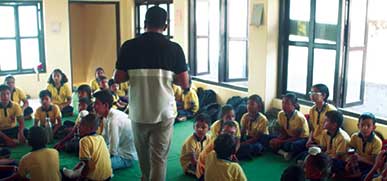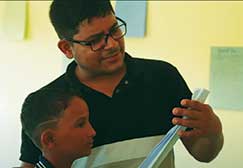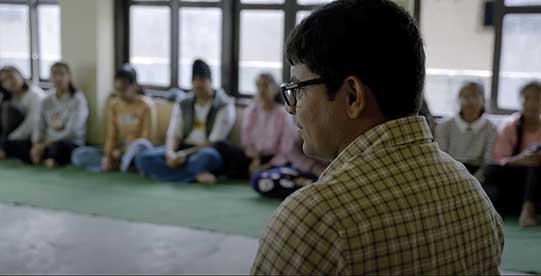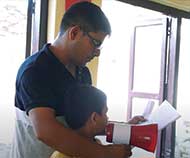Prakash Chand
The concept of a school has moved beyond physical infrastructure and facilities. Schools are increasingly seen as spaces which emphasize on critical thinking, creativity, collaboration, adaptability, and communication skills.
The challenge for schools today is to create a learning-focused environment that nurtures students’ overall development. An environment which equips the students with a broader set of skills – skills that enable them to thrive in a rapidly changing world. And, an environment which treats all students, irrespective of their backgrounds, in an equal manner.
Challenges that are daunting and which a few schools are able to meet. Let us talk about once such school. The Nanakmatta Public School (NPS).

A model for student-centered learning
NPS focuses on the principles of student-centered learning. Located in the Udham Singh Nagar district of Uttarakhand and co-founded and led by Kamlesh Atwal, who has an MPhil, MA, and PhD from Jawaharlal Nehru University (JNU), NPS aims to provide quality education to rural students. Kamlesh Atwal dropped his plans to become a professor and returned to his village to establish NPS and enable the children in rural Uttarakhand to have a better future.
NPS focuses on providing holistic learning experiences tailored to the context of rural Uttarakhand. The school prides itself on promoting student agency, encouraging students to engage in various projects and take ownership of their learning. It recognizes that education is a space for student ownership, where teachers and students become partners in the learning process, fostering a spirit of honest inquiry and lifelong learning.
Emphasizing student progress
The progress of a school should not be measured solely by the number of students it accommodates, but rather by the growth and progress of its students as learners. NPS devotes significant effort to equip students with the skills necessary to thrive in the modern world. To achieve this, the school has created flexible spaces where students can initiate and engage in their own projects, fostering collective learning and student ownership of their work.
Community: a learning space
NPS goes beyond the traditional boundaries of a school by creating innovative learning spaces within the community. Students from NPS have established over 20 community centres in various areas of Nanakmatta, aiming to provide educational opportunities for underprivileged children who cannot afford formal education. Through this initiative, students organize book fairs and science fairs within their communities, transforming these centres into vibrant spaces for learning.
One remarkable example is Ayesha, a 10th grade student who runs a community library in Dhyanpur village. Every evening, from 4 pm to 6 pm, approximately 30 to 40 children gather at her community centre to play, read, and learn together. Ayesha’s active participation in the community centre has had a profound impact on her classroom engagement. Kamlesh acknowledges the growth in Ayesha’s confidence and learning attitude, highlighting the positive influence of working with the community through this project.
The community centre initiative not only benefits Ayesha but also fosters positive leadership skills among many other students who take ownership of various responsibilities. These skills cannot be adequately learned within the confines of a traditional classroom, where independent and practical learning opportunities are limited.
The idea for the community centres was initially proposed by the education activist Mahesh Punetha. It began with a focus on providing books but later expanded to include a broader concept of community learning spaces. This project has successfully bridged the gap between students and their communities, recognizing the intrinsic link between education and the community.

Bridging practical and classroom learning through filmmaking
NPS goes a step further in bridging the gap between practical and classroom learning by providing students with opportunities to make films through field research. The students have created two documentary films to date. One film explores the lives of the Gujjars, a community that migrates for livelihood, and the other focuses on a community of fishermen that visits Nanakmatta during summers. These projects involve spending more than a month with the respective communities, engaging in continuous dialogue and daily visits.
Completion of these documentary films has inspired other students at NPS to create their own films. Through this process, students document the lives of people within their communities and learn from the experience. This Cinema in School initiative, with the guidance of cinema teacher Atul Kumar, integrates cinema into the learning curriculum. Screenings of movies related to the students’ books help them understand classroom concepts through visual and audio aids, facilitating comprehension.
While traditional classrooms often prioritize rote learning and abstract ideas, being part of NPS means being a learner of choice. Through documentary filmmaking, students become more connected to their communities. They develop sensitivity towards marginalized communities and gain a deeper understanding of social issues by actively working on the ground.
Wall magazine: students’ expression
To foster a vibrant writing and reading culture among students, NPS introduced a magazine called ‘The Explorer.’ Students took the initiative to form an editorial team responsible for collecting writings from their peers and engaging in the entire process of editing, proofreading, and publishing. This magazine serves as a compilation of students’ ideas, writings, cartoons, and articles, resembling a newspaper.
Over time, NPS students have developed different kinds of magazines. One notable format is the wall magazine, where students create a base using cardboard and paste their writings, drawings, and poems onto it. These vibrant displays are then hung on the assembly wall, allowing more students to read and appreciate the content. The process of creating a wall magazine not only nurtures artistic and craft skills but also fosters creativity. It requires teamwork, collaboration, and coordination among students, which aids in the development of essential 21st century skills.
In addition to physical magazines, students also release digital versions in PDF and PowerPoint formats. On occasions, due to limited material resources, students prefer this format. The digital magazine also allows the students to share their work with a wider audience, including parents, teachers, and mentors.
The introduction of magazines within the school environment has successfully cultivated a writing culture among the students. Writing is an essential practice that every student should be familiar with. Inspired by senior students, junior classes have also started releasing their own wall magazines with the support of their teachers. This initiative not only helps students build their writing skills but also provides an opportunity for them to learn from each other’s writing.

Documentation of rural life
As NPS is situated in a rural area, the school’s approach to learning is closely connected to its surroundings. The school recognized that students often remain oblivious to the stories and experiences happening around them, being unconscious of their immediate environment. When topics are studied in the classroom without context and reference, learning can become abstract and incomplete, limited to memorizing information rather than fostering personal growth.
To address this issue, students at NPS have taken on the task of documenting different real-life stories of ordinary people in their community. These stories encompass various aspects of rural life, including traditional art and craft, challenging narratives, social issues, and customs. Through a collaboration with the Peoples Archive of Rural India (PARI), NPS students have learned the art of reporting, data analysis, and conducting ground research.
The documentation project serves a dual purpose. Firstly, it enables students to gain a deeper understanding of the stories and experiences that surround them, allowing them to learn from the ordinary people they encounter in their day-to-day lives. Secondly, it provides senior students with practical examples that enrich their classroom learning. By connecting bookish concepts to real-life stories, students develop a better perspective on various topics, ultimately strengthening their academic understanding.
Through this project, NPS students become active participants in their community, gaining empathy, cultural appreciation, and a sense of connectedness. By documenting and preserving local stories and heritage, students develop a broader understanding of the world around them. The project bridges the gap between academic learning and practical approaches, empowering students to become lifelong learners who actively engage with their surroundings.
NPS initiatives, such as the wall magazine and the documentation of rural life, encourage students to express themselves creatively and connect their learning to real-world experiences. These endeavours not only enhance academic knowledge but also foster important skills such as writing, teamwork, creativity, and community engagement. By promoting a sense of ownership, cultural appreciation, and a deeper understanding of their surroundings, NPS equips students with the tools they need to thrive in the contemporary world.
Collaboration
NPS has strengthened its vision through collaborations with various individuals working in the field of education. Interacting with new people and being part of diverse opportunities has provided students with a broader perspective. Kamlesh, the driving force behind NPS, consistently offers students various opportunities and connects them with people who are genuinely passionate about working with students. Mahesh Punetha has been a continuous mentor, providing students with critical feedback and suggestions to help them become better versions of themselves. Cinema activist Sanjay Joshi offers students unique ideas related to films and cinema, while Ashutosh Upadhyay organizes science workshops. These collaborations, among others, have greatly contributed to NPS and its students in strengthening their shared aim.

Teachers as friends
Kamlesh values working with students and spending time with them. As a teacher, he believes that the school should be student-operated. He emphasizes that schools are part of a social structure and it is easy to run a system with a teacher monopoly but not through teacher domination. However, alternative learning requires dedicated teachers who genuinely want to work with students. Kamlesh firmly believes that education should not solely revolve around course books, but should incorporate various activities. He sees himself as a learner and an educational activist, always eager to witness his students working with utmost dedication in their respective fields. In addition to providing educational support, he offers emotional support to each student.
Conclusion
The initiatives by NPS are helping its students gain strong and impactful learning experiences. They have become an integral part of the school curriculum, with students earning marks based on their progress in these projects. The impact of these projects is more evident than traditional school learning among the students. Engaging in these projects has boosted their confidence to share their views and opinions. Students now have the opportunity to showcase their learning on various platforms across the country, such as Teach for India, Kids Education Revolution, and talk shows.
Today, many rural students from NPS have gained admission to prestigious educational institutes such as Ashoka University, Flames University, Azim Premji University and Delhi University. Kamlesh’s efforts extend not only to current students but also to those who have graduated and are seeking higher education. Most students at NPS admire him, and it is an environment where the students and Kamlesh work together as equals, fostering a partnership that creates a true learning environment in the school.
The author is passionate about writing and filmmaking. He is a part of NPS since 2015 and currently is a 12th grade humanity student.
